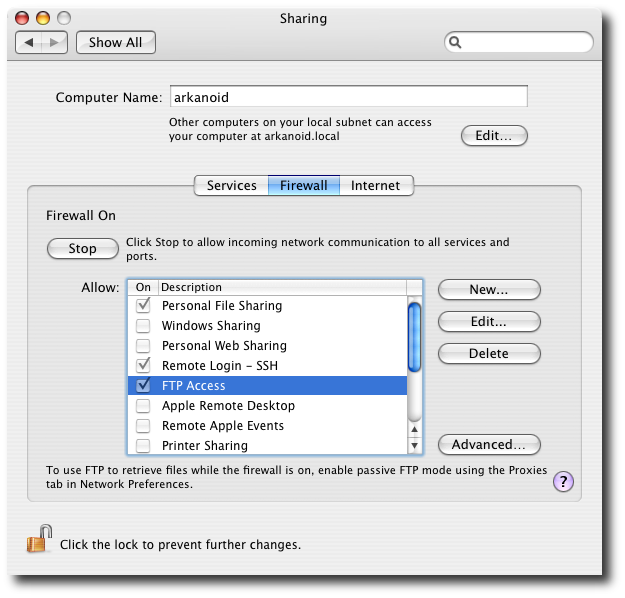I have Dreamweaver CC and Mac OS X 10.9.1 Mavericks. Everything is. I ended up turning off firewall settings in system preferences. Jun 21, 2016 - If the server is behind a firewall you should try active FTP mode, if the client is behind firewall you. Try changing the Transfer mode to 'Active'.
How to allow FTP port in Windows Firewall? Microsoft Windows XP service pack 2 comes with inbuilt Firewall. If Microsoft Windows Firewall is blocking a port that is used by a service or by a program, you can configure the Windows Firewall to create an exception. Windows Firewall may be blocking a program or a service if Programs do not respond to a client’s request or you do not get data from server. To open FTP port 21 you need to change Windows Firewall settings. • Click on Start > Settings > Control Panel > Click on Security center • At the bottom window (Manage security settings for:) you will see Windows Firewall option.
• Click on this option. It will open Windows Firewall dialog box: • Select Exceptions tab > Click on Add Port button • Add port 21 and 20 as follows. • Save Firewall settings by clicking on OK button. • You are done; now your Windows XP will allow incoming FTP connection. • Restart your PC. If you have any questions please and we will be happy to answer them! We appreciate your time to offer us your feedback and encourage you to continue to let us know how we can improve our products.

As our software is continually developed and improved, new features are always under consideration and your feedback is very helpful.
How to Use FTP from Terminal to Transfer Mac Files By You can use FTP to transfer files from your Mac OS X Snow Leopard computer with an FTP server by using the command-line interface (CLI); to use the CLI, open a Terminal, or shell, session. To use a Terminal session, double-click the Terminal icon in the Utilities folder inside the Applications folder. When you open a Terminal session, you’re presented with a window that accepts text commands.
You’ll see a prompt that consists of your computer’s name and the folder that you’re currently in, followed by your user ID. It’s at this prompt where you type various FTP commands. After you’re in the Terminal session, you’ll use a series of commands to connect to another computer, move in and out of folders, and transfer files.
Following is a list of the basic commands that you need to use FTP as well as a brief description of what each command does. • ftp: This command starts the FTP command line interface session. You can tell that you’re in the FTP client application when you see ftp> as your command prompt.
This is where you type all other FTP commands to do things. • open: This command is used to start your connection to another computer.
Type this command followed by the IP address of the FTP server that you want to connect to. • ls: Use this command to see a listing of all files and folders in the current folder on the FTP server. • cd: This command allows you to change the folder that you’re in. Type cd (where folder is a specific folder name) to move into a subfolder on the FTP server.
(that’s c, d, space, and two periods) to go back out a folder level. • lcd: This command acts exactly like cd except that it changes the folder that you’re currently in on your local system, not the FTP server. Use this command to put yourself in the folder on the local drive that you want to transfer files to and from. • bin: Type this command to get in binary mode to transfer files that aren’t plain-text files. ( Always use binary mode unless you’re specifically transferring plain-text files.) • ascii: This command puts you in ASCII mode for transferring text files. • get or mget: To retrieve a single file, use the get command followed by the filename of the file that you want to retrieve. If you want to get multiple files at one time, use the mget command followed by a filename, possibly containing * and/or?

As wildcards. • put or mput: To send a single file, use the put command followed by the filename to send a file to the FTP server. To send multiple files, use the mput command followed by a filename, possibly containing * and/or? As wildcards. • quit: Use the quit command to end your FTP session.

 0 kommentar(er)
0 kommentar(er)
